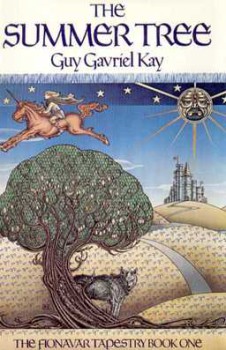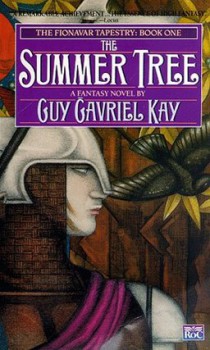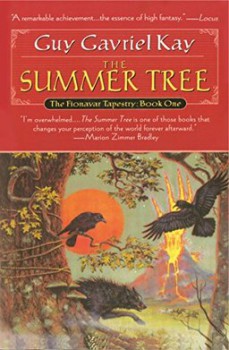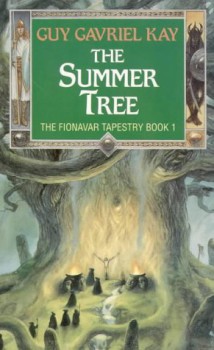The Fionavar Tapestry Book 1: The Summer Tree by Guy Gavriel Kay
 While Guy Gavriel Kay is probably best known for his fantasies set in lightly fictionalized versions of the real world — such as The Lions of Al-Rassan or the Sarantine duology — his first book was The Summer Tree (1984). It’s the opening volume of The Fionavar Tapestry, a trilogy of epic high fantasy that manages to cram into its pages nearly every important Germanic or Celtic myth you can think of. You want a dark lord in an impregnable northern fortress? Check. How about noble elves practically glowing with an inner light, and noble blond horse-nomads? Double check. Considering that at the age of twenty, Kay was picked by Christopher Tolkien to help him collate his father’s papers into The Silmarillion, it’s understandable.
While Guy Gavriel Kay is probably best known for his fantasies set in lightly fictionalized versions of the real world — such as The Lions of Al-Rassan or the Sarantine duology — his first book was The Summer Tree (1984). It’s the opening volume of The Fionavar Tapestry, a trilogy of epic high fantasy that manages to cram into its pages nearly every important Germanic or Celtic myth you can think of. You want a dark lord in an impregnable northern fortress? Check. How about noble elves practically glowing with an inner light, and noble blond horse-nomads? Double check. Considering that at the age of twenty, Kay was picked by Christopher Tolkien to help him collate his father’s papers into The Silmarillion, it’s understandable.
The Summer Tree is a book of beginnings and setting the pieces on the table. The game that will be played out in the two succeeding books, The Wandering Fire and The Darkest Road, is the usual one of long-imprisoned dark lord frees himself and sets out to get right this time his efforts to subvert creation and rule the world. Or in this book’s case, THE WORLD. Fionavar is the first world, the one from which all others, ours included, spring and are but shadows of.
The book opens in Toronto where five grad students, Jennifer, Kevin, Kimberly, Paul, and Dave go to hear Prof. Lorenzo Marcus lecture at the Second International Celtic Conference. He reveals to them that he is really Loren Silvercloak, a sorcerer from another world, and he would like them to travel back there with him for two weeks. In one of the book’s weaker moments, it doesn’t take much to convince them to go along. Dave balks at the last minute, which results in him arriving in a far different part of Fionavar than his friends, and having several chapters all to himself. What none of them knows is that while Loren has said he simply wants them to cross over in order to be present at a celebration for the king, the reality is he knows they have yet undetermined roles to play in Fionavar.
Fionavar is a world about to fall into chaos. The High King of Brennin is aged, his kingdom alone in all Fionavar has been stricken by a devastating drought, and he has driven his eldest son into exile. Svart alfars, vicious, bestial humanoids, have been seen for the first time in centuries. Visions of the coming tumult have plagued Ysanne the Seer of Brennin. In his prison under the mountain, Maugrim the Unraveller prepares to break free. By the book’s midpoint he will be released and all Fionavar will know it.
exile. Svart alfars, vicious, bestial humanoids, have been seen for the first time in centuries. Visions of the coming tumult have plagued Ysanne the Seer of Brennin. In his prison under the mountain, Maugrim the Unraveller prepares to break free. By the book’s midpoint he will be released and all Fionavar will know it.
As I wrote, The Summer Tree serves to introduce the players and set them in motion. Some of the students begin to fall into the roles they seemed fated for, some seem random and tragic, but they all will be important. Secrets are unveiled and plots exposed. By the novel’s end the forces of dark and light are readying themselves for the war that is sure to come.
In examining epic high fantasy this past month or so, one aspect I’ve touched on unintentionally is the motives of the authors for creating their stories. The Sword of Shannara was Terry Brooks’ and the del Reys’ attempt to create a less taxing, commercially viable Tolkien pastiche. Stephen Donaldson, in the Thomas Covenant books, examined perception versus reality, and the consequences of choices using epic fantasy tropes. Joy Chant wanted to write an enthralling story sparked in equal parts by her childhood imagination and The Lord of the Rings.
Coming along well into the epic fantasy book boom of the late 1970s and early 80s, Kay had a distinct reason for writing the Fionavar Tapestry. In a 2000 interview with the magazine Challenging Destiny, he explained:
Well, Fionovar was planned as a trilogy because it was a self-conscious, self-aware attempt to make a statement. In retrospect it’s amusing. But back then I was “shocked and appalled” at the barbarians in the temple — the post-Tolkien trivialization of fantasy that I saw happening. And the serious writers of fantasy — the people I respected — were it seemed to me turning away from epic fantasy to other kinds of smaller scale work. Urban fantasy was born around that time — people like Megan Lindholm, Charles de Lint. Small, precise, nicely done books. But they were almost a kind of abandoning of the field of the epic scale to the hacks. And it ticked me off a bit. It seemed to me a premature abandonment. I really felt that the elements of high fantasy — the elements that Tolkien had taken from myth and legend — not the elements he invented, the elements he took from primary sources — were still there to be taken and worked with. And they could be recombined in different ways — you could work with those same core elements and come to a different destination. And so Fionovar was very consciously a statement that I’m going to do a tremendous number of the formulaic things — it’s going to even be a trilogy. Back then a trilogy was standard, now it’s as far as you want to go. A trilogy was almost synonymous with big fantasy. I’m going to address the middle book problem — a specific creative dilemma you have when you’re doing a trilogy. I’m going to work with figures such as elves and dwarves and magic and prophecy. I’m going to consciously take these elements and try to add to them characterization, complexity of motivation, ambiguity of morality — and see if it’s possible to marry these things and produce something that can at least lay claim to having merit. And so that was a deliberate trilogy.
 With as much deliberateness of purpose as the del Reys brought to bear in order to create a profitable book, Kay set out to create one with greater respect for its antecedents and elevated literary goals. For the most part he succeeded. The depth of the psychology and emotions of characters in this book stands in stark contrast to the cookie cutter assemblages that began to fill the ranks of epic fantasy post-Sword of Shannara. The students grow far beyond their simple descriptions at the book’s start. While there are forces of good and evil in Fionavar, many of each have a strong touch of gray in them. Not everything that happens is tied directly to the oncoming conflict between those two sides. Some individuals insist on acting out of their own personal ambitions, even if it might be against the greater good. Without ever diminishing its deeply interwoven fantasy elements, Kay created in Fionavar a world and inhabitants that seem realer than many in fantasy.
With as much deliberateness of purpose as the del Reys brought to bear in order to create a profitable book, Kay set out to create one with greater respect for its antecedents and elevated literary goals. For the most part he succeeded. The depth of the psychology and emotions of characters in this book stands in stark contrast to the cookie cutter assemblages that began to fill the ranks of epic fantasy post-Sword of Shannara. The students grow far beyond their simple descriptions at the book’s start. While there are forces of good and evil in Fionavar, many of each have a strong touch of gray in them. Not everything that happens is tied directly to the oncoming conflict between those two sides. Some individuals insist on acting out of their own personal ambitions, even if it might be against the greater good. Without ever diminishing its deeply interwoven fantasy elements, Kay created in Fionavar a world and inhabitants that seem realer than many in fantasy.
Fionavar is a world of great beauty and haunted places brought to light by the deep and moving history Kay has created. He relays it through tales told by various Fionavarans to the students. Even the Fionavarans struggle to understand their history, oftentimes not knowing the truth of what happened in past centuries. Like us, the stories they tell, whether actually true or simply what’s believed true, retain real power, continuing to shape the present. Again, Kay has a better understanding of the nature of history and myth than so many other writers of fantasy epics. This understanding gives The Summer Tree emotional resonance. Drawn from the deep wells of German and Celtic myths, stories so deeply woven into Western culture, the book at times feels like it really might be a lost collection of real world legends, just as Joy Chant’s Red Moon and Black Mountain, and of course, J. R.R. Tolkien’s LotR do.
 I have some quibbles with the book. As I mentioned at the start, the five Canadians are won over by Loren Silvercloak a little too easily. That they don’t just call the psych ward is a little unbelievable. Kay’s attempt to impart a sense of “storytelling with a capital S” by using a supposedly formal diction sounds stilted instead, especially as the students speak in 1980s North American English for quite a while. So, instead of just being dressed in white, Kimberly “All in white, she was…” Over time they do start to sound more like the native Fionavarans and I suspect that’s deliberate, showing they are becoming woven into a new world. Also, for all the variety of people and civilizations of Fionavar, there’s a sparseness, too. There’s a Potemkin village feel much of the time: lots of business in the foreground but nothing going on behind that. Despite the epic elements (five-fingered flame-hand erupting out of a volcano, giant evil black swan with teeth, gods walking the land, etc.), The Summer Tree’s stage feels very small sometimes.
I have some quibbles with the book. As I mentioned at the start, the five Canadians are won over by Loren Silvercloak a little too easily. That they don’t just call the psych ward is a little unbelievable. Kay’s attempt to impart a sense of “storytelling with a capital S” by using a supposedly formal diction sounds stilted instead, especially as the students speak in 1980s North American English for quite a while. So, instead of just being dressed in white, Kimberly “All in white, she was…” Over time they do start to sound more like the native Fionavarans and I suspect that’s deliberate, showing they are becoming woven into a new world. Also, for all the variety of people and civilizations of Fionavar, there’s a sparseness, too. There’s a Potemkin village feel much of the time: lots of business in the foreground but nothing going on behind that. Despite the epic elements (five-fingered flame-hand erupting out of a volcano, giant evil black swan with teeth, gods walking the land, etc.), The Summer Tree’s stage feels very small sometimes.
The story, of the return of evil and the struggle to marshall the forces of good to combat it, is one we’ve read, and read again. Even if you picked up The Summer Tree when it first came out over thirty years ago, its overall outline would not have been original. So why should you bother to read it if you’ve already read The Lord of the Rings? Well, probably because it’s a good story well done. If you like the blues you can listen to Eric Clapton as well as John Lee Hooker. Both start with the same source material but bring different ideas, strengths, and weaknesses to create a unique take on it. Same thing here.
I read this trilogy nearly a decade ago and liked it just for the story Kay was telling. Now, studying its parts and mechanics, trying to understand better what Kay intended, I like it a little bit more. Without slipping into the gray and gray morality common to today’s fantasy (and seen as some sort of antidote to the supposedly simplistic black and white morality of Tolkien), Kay managed to take on the Tolkien-clones and show there was real, artistic life left in the form. This is how epic high fantasy can look if it doesn’t want to merely ape LotR or regurgitate the same bits and pieces over and over again
Fletcher Vredenburgh reviews here at Black Gate most Tuesday mornings and at his own site, Swords & Sorcery: A Blog when his muse hits him. You can read his thoughts about epic high fantasy here.
I always associate Guy Gavriel Kay not so much with his own work as with the fact that he helped edit The Silmarillion.
I discovered Fionavar back in high school, and read it fast on the heels of Tolkien, Weis & Hickman, Brooks, Moorcock, and Donaldson. I was still relatively new to epic fantasy, and I was completely blown away by the trilogy. Understanding how deliberately he was trying to resurrect the ‘epic’ aspect and deliver on the tropes just makes me appreciate it more.
Ironically, I was actually disappointed at the time with his subsequent novels because they strayed so far from those tropes. It really wasn’t until I hit my 30s that I could appreciate the likes of Tigana, A Song for Arbonne, and Under Heaven.
I have been in love with Guy Gavriel Kay’s writing for years. Thank you for reviewing this! I hope to see more of his books reviewed in the future
I vaguely knew of Kay, but didn’t read any of his stuff until Lions of Al-Rassan (which was wonderful), at which point I went back and read the prior books as well.
Which is just as well — I have a friend who read the first two Fionavar books when they first came out, but the third one didn’t get a US release until years after the fact, I believe, and this was at a point when there wasn’t any good way to get non-US books.
@Amy Bisson – Apparently both he and Christopher Tolkien assumed he would serve as a mere assistant, but ended up being more of a collaborator.
@Beauty – While I’m not overly interested in his “historical” fantasies, I would like to get to Tigana and Arbonne someday
@Ysabel – Thank you, for the kind words.
@JoeH – I remember having to spend tons of extra $ at the old NYC Forbidden Planet to get my hands on imports. Glad those days are done.
Tigana was the first Kay I read, in my early 20s. It was a really mature work with a lot of original stuff going on, and after reading it, I found it hard to backtrack to the deliberately derivative Fionavar books and enjoy them.
The more organic feel of straight secondary-world fantases consistently appeals to me more than portal fantasies do. The whole portal business always feels contrived to me, even when it’s well done. Perhaps I was always going to be the wrong reader for Kay’s first series.
Fionavar isn’t my favorite of Kay’s work (I’ve read everything but, I think, the second Chinese-influenced novel) but I think it was probably the series he had to write first.
I’d definitely recommend checking out Al-Rassan and also Sarantium at some point — Sarantium has the best chariot race I’ve ever read (followed closely by that in Tanith Lee’s Birthgrave).
I picked this up in my last year of high school back in the 80s and absolutely fell in love with it. Sure, it’s heaped high with tropes, and its antecedants are right there on the page, but it is so beautifully, achingly well written that you can’t but love it all. While Kay has wandered of into pseudo-historical fiction, I’d love for him to come back to something like this. A highlight of my reading life!
Thanks a lot for the nice review, Fletcher.
I’ve said that before, but for some reason The Fionavar Tapestry didn’t work me at all.
Actually I found that the first book was quite acceptable: Kay has a talent for language and is able to switch from conventional to more epic tome in a semless way. There were interesting backstories, expecially Paul’s story, but all the tension lied outside the fantasy world, outside Fionavar itself.
And here comes the real weakness: despite being (supposedly) the First World, Fionavar seems to me extremely paper-thin , weak, a two-dimensional world populated by cadboard charachters whose reason to exist is just to interact with the 5 terrestrial protagonists bring the plot forward. The different cultures (pseudo-chinese, pseudo-native americans, and pseudo-medieval europe) and peoples of Fionavar do not amalgamate well together and this contributes to give a sense of fakeness to the world. Even the Celtic and “Nordic” elements do not mix well together for my tastes (Tolkien was really good in this kind of job, using old elements and blend them together semlessly)
Worlds usually blamed to be lame copies of Tolkien, like the Four lands Shannara or even McKiernan’s Mithgard show more internal coherence and more careful worldbuiling.
Finally, Kay claims he wanted to go back to the true sources of myth like Tolkien did. Fine, but the main thread of plot, the reawekening of some ancient evil (The Ancient Evil) is a concept that was never foun in traditional myths, before Tolkien made it popular with the LOTR and the Silmarillion. So, Kay was going back to the old myths but also taking direct inspiration from Tolkien, just as “the barbarians” (what a snobbish concept!) were doing before him.
— SPOILERS AHEAD
The fact that characters exist only to fring the plot forward shows clearly with Rakoth. He is supposed to be the single greatest force in Fionavar, nobody (not even the Gods) is strong enough to face him (how was he imprisoned in the first instance? that’s never explained), but the he suffers by a bad case of “Orcus on his Throne”.
He does nothing for three books but one blatant evil action, and it is by that action that he is brought down! Too little, for such a strong force evil.
— END SPILER
The last book was just bad and filled with implausible plot events, a real pain for me to finish, but I liked the lady of Shalott chapter.
I was sorry in the end because I had rather high expectations for these books.
Maybe I should try some of his later works, but I am not so much in alternative history.
@Sarah A. – I’m a grade A sucker for a well done portal fantasy myself. Reading various comments about this book I was actually surprised to learn how many readers simply don’t like them.
@JoeH – I’m more curious about Tigana and Song for Arbonne
@Robert M. – I really didn’t do justice to describing the beauty of some parts of the book.
@MorgonMax – I disagree regarding the tension vis-à-vis in the real world vs. Fionavar, but I do agree about the “thinness” of the latter. For the supposed ur-universe it comes across a little too stage-like and transparent at times.